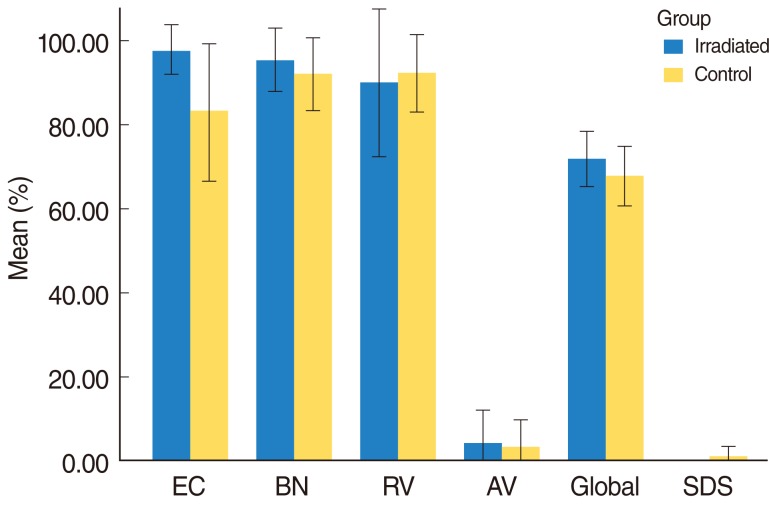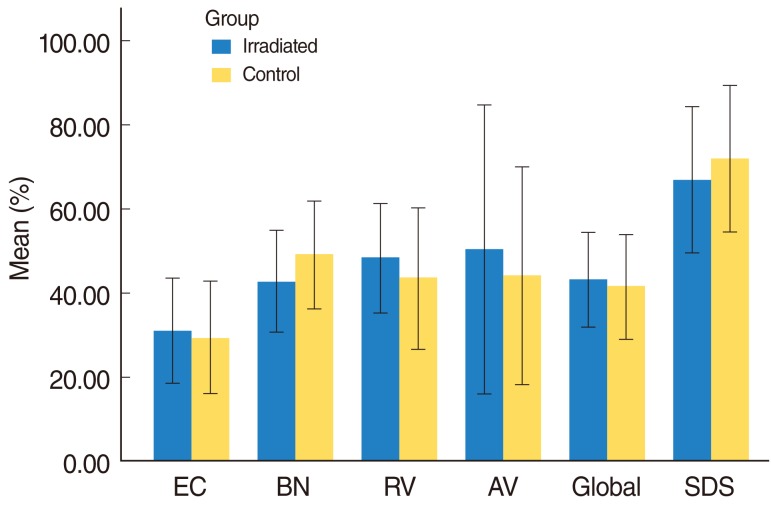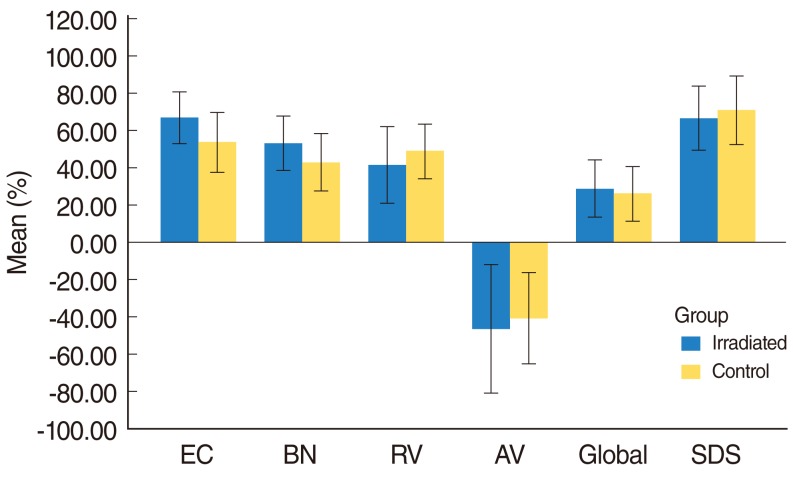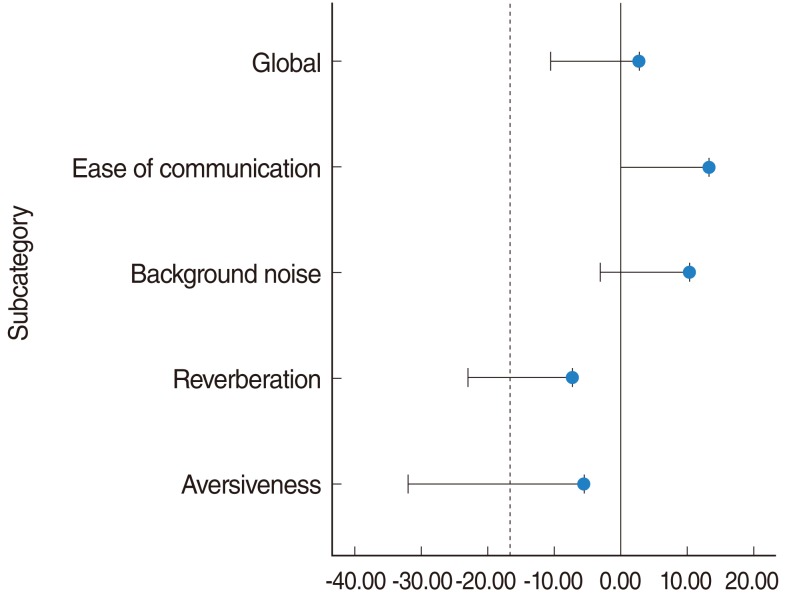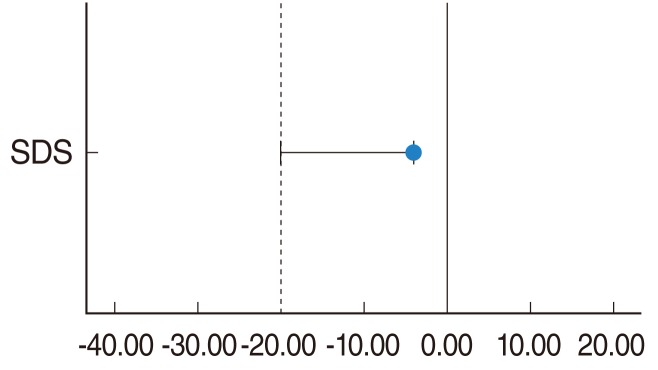Clin Exp Otorhinolaryngol.
2012 Apr;5(Suppl 1):S93-S98.
Cochlear Implant Outcomes: A Comparison between Irradiated and Non-irradiated Ears
- Affiliations
-
- 1Department of Otolaryngology, Singapore General Hospital, Singapore. low.wong.kein@sgh.com.sg
Abstract
OBJECTIVES
Radiotherapy for head and neck tumors is known to potentially induce sensorineural hearing loss, which is possibly due to damage to the cochlear and/or auditory pathways. Since the success of cochlear implantation depends on a functional auditory nerve, this paper aims to study the hearing outcomes of cochlear implantation in irradiated ears.
METHODS
A retrospective study of cochlear implant recipients from our institution who had previously received radiotherapy for head and neck cancers was performed. A control group with cochlear implants who did not receive radiotherapy was recruited. A review of case records, speech discrimination scores (SDS), and a validated subjective questionnaire in the form of the Abbreviated Profile of Hearing Aid Benefit (APHAB) was administered to the study group who fulfilled the inclusion criteria. Global and category scores in both groups were averaged and statistically compared via non-inferiority (NI) testing.
RESULTS
With the control group (n=8) as the reference, the -DeltaNI was defined, and a one-tailed lower 95% confidence interval was used for the irradiated group (n=8). The APHAB degree of improvement (%) results were as follows: global, 28.9% (19.32%, -DeltaNI=16.3%); ease of communication, 67.0% (58.36%, -DeltaNI=37.5%); background noise, 53.2% (44.14%, -DeltaNI=26.8%); reverberation, 41.7% (28.85%, -DeltaNI=32.7%); and aversiveness, -46.2% (-67.80%, -DeltaNI=-56.9%). The SDS was 66.9% (56.02%, -DeltaNI=51.0%). From the results, lower 95% confidence interval limits of global APHAB, SDS, ease of communication, and background noise scores of the irradiated group were within the defined -DeltaNI boundary and hence are not inferior to the control. The categories of reverberation and aversiveness could not be proven, however.
CONCLUSION
This study demonstrated marked improvements in hearing measured both objectively and subjectively. The overall hearing outcomes after cochlear implantation for post-irradiated patients were not worse than patients who have had no prior irradiation to ear structures.
Keyword
MeSH Terms
Figure
Reference
-
1. Low WK, Burgess R, Fong KW, Wang DY. Effect of radiotherapy on retro-cochlear auditory pathways. Laryngoscope. 2005; 10. 115(10):1823–1826. PMID: 16222203.
Article2. Ho WK, Wei WI, Kwong DL, Sham JS, Tai PT, Yuen AP, et al. Long-term sensorineural hearing deficit following radiotherapy in patients suffering from nasopharyngeal carcinoma: a prospective study. Head Neck. 1999; 9. 21(6):547–553. PMID: 10449671.
Article3. Bohne BA, Marks JE, Glasgow GP. Delayed effects of ionizing radiation on the ear. Laryngoscope. 1985; 7. 95(7 Pt 1):818–828. PMID: 4010422.
Article4. Low WK, Gopal K, Goh LK, Fong KW. Cochlear implantation in postirradiated ears: outcomes and challenges. Laryngoscope. 2006; 7. 116(7):1258–1262. PMID: 16826071.
Article5. Yue V, Leung EK, Wong TK, Tong MC, Van Hasselt CA. Cochlear implantation for post-irradiation deafness. Cochlear Implants Int. 2004; 9. 5(Suppl 1):165–168. PMID: 18792283.
Article6. Chua DY, Thong MK, Tan HK, Govil S. Successful rehabilitation with cochlear implant in post-irradiation-induced hearing loss in nasopharyngeal carcinoma patient. Cochlear Implants Int. 2004; 9. 5(Suppl 1):158–161. PMID: 18792281.
Article7. Formanek M, Czerny C, Gstoettner W, Kornfehl J. Cochlear implantation as a successful rehabilitation for radiation-induced deafness. Eur Arch Otorhinolaryngol. 1998; 255(4):175–178. PMID: 9592673.
Article8. Beynon AJ, Snik AF, van den Broek P. Comparison of different speech coding strategies using a disability-based inventory and speech perception tests in quiet and in noise. Otol Neurotol. 2003; 5. 24(3):392–396. PMID: 12806290.
Article9. Litovsky R, Parkinson A, Arcaroli J, Sammeth C. Simultaneous bilateral cochlear implantation in adults: a multicenter clinical study. Ear Hear. 2006; 12. 27(6):714–731. PMID: 17086081.
Article10. Gifford RH, Dorman MF, Spahr AJ, McKarns SA. Effect of digital frequency compression (DFC) on speech recognition in candidates for combined electric and acoustic stimulation (EAS). J Speech Lang Hear Res. 2007; 10. 50(5):1194–1202. PMID: 17905905.
Article11. Anteunis LJ, Wanders SL, Hendriks JJ, Langendijk JA, Manni JJ, de Jong JM. A prospective longitudinal study on radiation-induced hearing loss. Am J Surg. 1994; 11. 168(5):408–411. PMID: 7977961.
Article12. Lau SK, Wei WI, Sham JS, Choy DT, Hui Y. Early changes of auditory brain stem evoked response after radiotherapy for nasopharyngeal carcinoma: a prospective study. J Laryngol Otol. 1992; 10. 106(10):887–892. PMID: 1474310.13. Kwong DL, Wei WI, Sham JS, Ho WK, Yuen PW, Chua DT, et al. Sensorineural hearing loss in patients treated for nasopharyngeal carcinoma: a prospective study of the effect of radiation and cisplatin treatment. Int J Radiat Oncol Biol Phys. 1996; 9. 36(2):281–289. PMID: 8892450.
Article14. Skarzynski H, Lorens A, Piotrowska A, Anderson I. Partial deafness cochlear implantation provides benefit to a new population of individuals with hearing loss. Acta Otolaryngol. 2006; 9. 126(9):934–940. PMID: 16864490.
Article15. Vermeire K, Brokx JP, Wuyts FL, Cochet E, Hofkens A, Van de Heyning PH. Quality-of-life benefit from cochlear implantation in the elderly. Otol Neurotol. 2005; 3. 26(2):188–195. PMID: 15793403.
Article16. Orabi AA, Mawman D, Al-Zoubi F, Saeed SR, Ramsden RT. Cochlear implant outcomes and quality of life in the elderly: Manchester experience over 13 years. Clin Otolaryngol. 2006; 4. 31(2):116–122. PMID: 16620330.17. Johnson JA, Cox RM, Alexander GC. Development of APHAB norms for WDRC hearing aids and comparisons with original norms. Ear Hear. 2010; 2. 31(1):47–55. PMID: 19692903.
Article18. Leung TW, Tung SY, Sze WK, Wong FC, Yuen KK, Lui CM, et al. Treatment results of 1070 patients with nasopharyngeal carcinoma: an analysis of survival and failure patterns. Head Neck. 2005; 7. 27(7):555–565. PMID: 15880410.
Article
- Full Text Links
- Actions
-
Cited
- CITED
-
- Close
- Share
- Similar articles
-
- Comparison of irradiated and non-irradiated acellular dermal matrices in breast reconstruction under radiotherapy
- Study on the Recovery of Epidermal Langerhans Cells in C3H Mice after UVA Irradiation
- Histomorphometric study on the influence of steroid topical irrigation and implant surface on bone healing in the irradiated rabbit tibia
- Irradiated Blood Usage in a Tertiary-care Hospital
- Implants in irradiated bone

